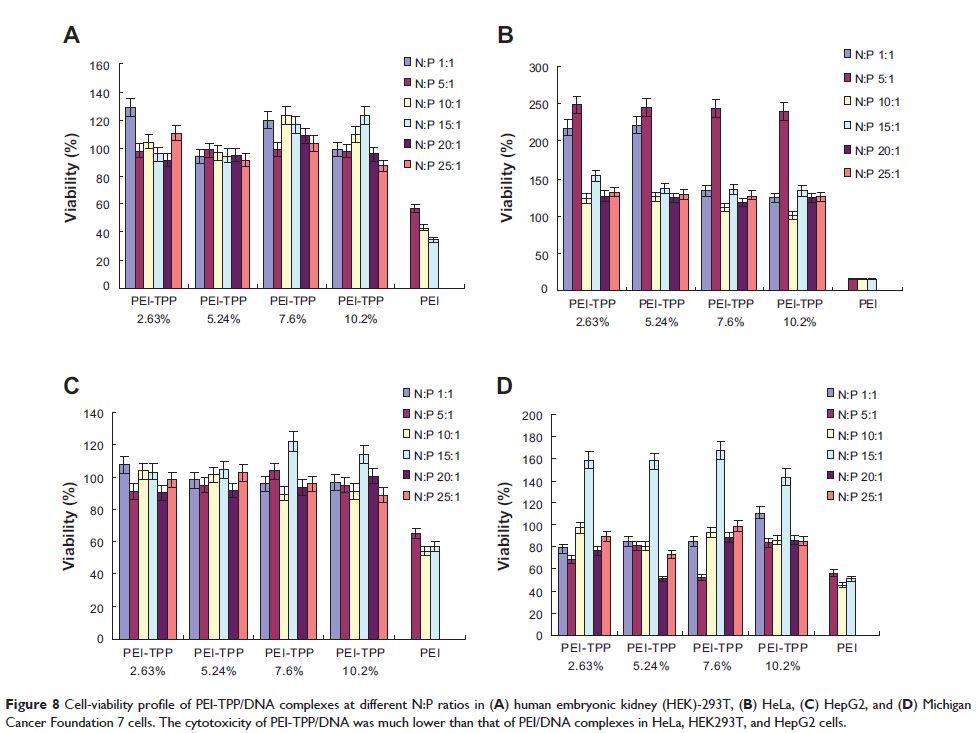108552
论文已发表
注册即可获取德孚的最新动态
IF 收录期刊
- 3.4 Breast Cancer (Dove Med Press)
- 3.2 Clin Epidemiol
- 2.6 Cancer Manag Res
- 2.9 Infect Drug Resist
- 3.7 Clin Interv Aging
- 5.1 Drug Des Dev Ther
- 3.1 Int J Chronic Obstr
- 6.6 Int J Nanomed
- 2.6 Int J Women's Health
- 2.9 Neuropsych Dis Treat
- 2.8 OncoTargets Ther
- 2.0 Patient Prefer Adher
- 2.2 Ther Clin Risk Manag
- 2.5 J Pain Res
- 3.0 Diabet Metab Synd Ob
- 3.2 Psychol Res Behav Ma
- 3.4 Nat Sci Sleep
- 1.8 Pharmgenomics Pers Med
- 2.0 Risk Manag Healthc Policy
- 4.1 J Inflamm Res
- 2.0 Int J Gen Med
- 3.4 J Hepatocell Carcinoma
- 3.0 J Asthma Allergy
- 2.2 Clin Cosmet Investig Dermatol
- 2.4 J Multidiscip Healthc

已发表论文
聚乙烯亚胺 - 三聚磷酸钠交联的纳米颗粒用于基因递送
Authors Huang XZ, Shen SJ, Zhang ZF, Zhuang JH
Published Date October 2014 Volume 2014:9(1) Pages 4785—4794
DOI http://dx.doi.org/10.2147/IJN.S61910
Received 5 February 2014, Accepted 23 March 2014, Published 16 October 2014
Abstract: The high transfection efficiency of polyethylenimine (PEI) makes it an attractive potential nonviral genetic vector for gene delivery and therapy. However, the highly positive charge of PEI leads to cytotoxicity and limits its application. To reduce the cytotoxicity of PEI, we prepared anion-enriched nanoparticles that combined PEI with tripolyphosphate (TPP). We then characterized the PEI-TPP nanoparticles in terms of size, zeta potential, and Fourier-transform infrared (FTIR) spectra, and assessed their transfection efficiency, cytotoxicity, and ability to resist deoxyribonuclease (DNase) I digestion. The cellular uptake of PEI-TPP with phosphorylated internal ribosome entry site–enhanced green fluorescent protein C1 or FAM (fluorouracil, Adriamycin [doxorubicin] and mitomycin)-labeled small interfering ribonucleic acids (siRNAs) was monitored by fluorescence microscopy and confocal laser microscopy. The efficiency of transfected delivery of plasmid deoxyribonucleic acid (DNA) and siRNA in vitro was 1.11- to 4.20-fold higher with the PEI-TPP particles (7.6% cross-linked) than with the PEI, at all N:P ratios (nitrogen in PEI to phosphorus in DNA) tested. The cell viability of different cell lines was more than 90% at the chosen N:P ratios of PEI-TPP/DNA complexes. Moreover, PEI-TPP nanoparticles resisted digestion by DNase I for more than 2 hours. The time-dependent absorption experiment showed that 7.6% of cross-linked PEI-TPP particles were internalized by 293T cells within 1 hour. In summary, PEI-TPP nanoparticles effectively transfected cells while conferring little or no toxicity, and thus have potential application in gene delivery.
Keywords: polyethylenimine (PEI), tripolyphosphate (TPP), nanoparticles (NPs), transfection
Keywords: polyethylenimine (PEI), tripolyphosphate (TPP), nanoparticles (NPs), transfection
